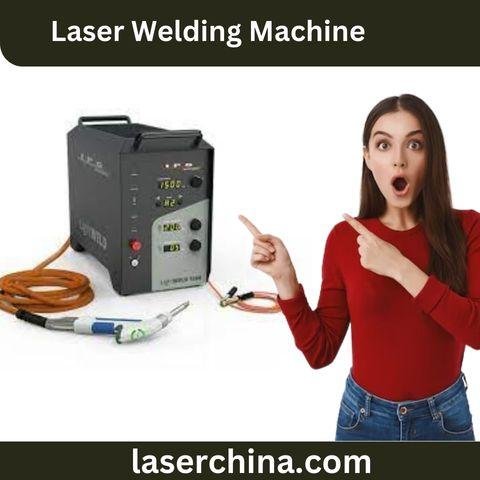In the evolving world of industrial manufacturing, precision, durability, and speed define success. Among the advanced technologies shaping this field, the laser welding machine has emerged as a game-changer. It’s no longer just an innovation—it’s an essential part of modern production lines, offering unmatched control over metal joining processes. From small workshops to large-scale industries, this technology redefines how metals are welded, fused, and refined to perfection.
Understanding the Laser Welding Process
A laser welding machine uses a concentrated beam of light energy to melt and join metal pieces together. The process begins when the laser beam is directed precisely onto the workpiece, creating a localized heat zone. This intense energy melts the metal edges, forming a strong and clean joint upon cooling.
Unlike traditional welding methods that rely on electrodes or filler materials, the laser beam delivers heat with pinpoint accuracy. This precision minimizes deformation, reduces post-processing work, and ensures consistent results even with complex or delicate components. The entire process can be automated, ensuring reliability and repeatability in high-volume manufacturing.
Applications Across Industries
The laser welding machine has expanded beyond metal workshops to become indispensable across multiple sectors.
-
Automotive Industry: In vehicle production, laser welding ensures lightweight yet durable body structures. Manufacturers use it for components like fuel injectors, transmission parts, and battery packs for electric vehicles.
-
Aerospace Manufacturing: High-strength joints are crucial in aircraft construction. Laser welding provides accuracy and minimal distortion in aluminum and titanium parts, ensuring flight safety and performance.
-
Medical Equipment: From surgical instruments to implants, laser welding delivers clean, precise joints that meet strict hygiene and durability standards.
-
Electronics Industry: Circuit boards, sensors, and micro-components benefit from non-contact welding, ensuring delicate structures remain intact.
-
Jewelry and Fine Metalwork: Craftsmen use compact laser welding systems for intricate repairs and joining precious metals without visible marks.
This versatility is what positions the laser welding machine as a vital component in industrial progress.
Technology Behind Laser Welding Machines
At its core, a laser welding machine consists of several essential components: a laser source, optical system, control unit, and sometimes a robotic arm or positioning system. The type of laser used—whether fiber, CO₂, or solid-state—determines the machine’s performance, beam quality, and material compatibility.
Fiber laser systems have become particularly popular due to their high efficiency and low maintenance. They produce a stable beam capable of deep penetration welding, ideal for thick or reflective metals. In contrast, CO₂ lasers are preferred for non-metal materials or applications requiring smooth surface finishes.
The control unit is the brain of the system, adjusting beam power, pulse duration, and focus position. With precise automation and computer integration, operators can control every parameter for consistent and defect-free welds.
Why Laser Welding Machines are the Future of Metal Joining
The rise of the laser welding machine is not just due to its precision—it’s about how it aligns with the global shift toward smarter, cleaner, and faster manufacturing.
Traditional welding often results in thermal distortion and requires significant post-processing. Laser welding minimizes these issues by delivering heat only where necessary. The narrow heat-affected zone reduces structural stress and preserves the mechanical integrity of materials.
In industries where downtime means loss, laser systems also offer faster setup and shorter cycle times. They can be easily integrated into automated lines, enabling continuous production with minimal supervision. This combination of accuracy, speed, and automation places laser welding at the center of Industry 4.0 manufacturing strategies.
Role in Sustainable Manufacturing
Sustainability is becoming a defining factor in industrial operations, and the laser welding machine contributes significantly to this goal. Its energy-efficient process reduces waste and consumption of filler materials. The precision of laser energy means fewer reworks, less scrap, and longer-lasting joints—all contributing to lower production costs and environmental impact.
Additionally, as industries transition toward lightweight materials like aluminum alloys and composites, laser welding adapts seamlessly. It can join dissimilar materials that traditional welding struggles with, allowing engineers to design stronger yet lighter components that enhance energy efficiency in transportation and manufacturing.
Automation and Smart Control in Laser Welding
Automation is the key to scaling production without compromising quality, and modern laser welding machines are built for this transformation. Equipped with CNC systems, robotic arms, and vision-based monitoring, these machines operate with exceptional precision.
Smart control systems track temperature, penetration depth, and weld consistency in real time. With advanced sensors and software, even minor deviations can be corrected automatically during the process. This level of intelligent control eliminates human error and ensures every product meets exacting specifications.
Moreover, integration with factory automation networks allows seamless data exchange, enabling predictive maintenance and operational optimization. This interconnected approach enhances productivity while maintaining high standards of reliability.
Precision in Design and Quality Control
In industries like aerospace and medical manufacturing, where precision determines safety and function, the laser welding machine delivers unparalleled results. The narrow beam diameter ensures that only the required area is heated, maintaining tight tolerances and aesthetic finishes.
This precision extends beyond welding—it improves overall quality control. Laser-welded joints have uniform structure, minimal porosity, and exceptional strength. Manufacturers can maintain consistency across large production batches without variation in results, a critical factor in global supply chains.
Maintenance and Longevity
To sustain performance, regular maintenance of a laser welding machine is crucial. Components such as optics, cooling systems, and protective lenses require periodic inspection and cleaning to prevent dust buildup and beam scattering.
Software calibration also ensures stable output power and accurate beam focus. Many modern systems feature diagnostic tools that alert operators to potential issues before they affect performance. When properly maintained, a laser welding machine can operate reliably for many years, offering long-term value and stability to any production environment.
Choosing the Right Laser Welding Machine
Selecting a suitable laser welding machine depends on several factors: material type, thickness, production scale, and automation requirements.
For example, industries needing deep penetration welding of steel often opt for high-power fiber lasers. In contrast, precision industries like jewelry or electronics prefer lower-power systems with microscope attachments for detailed work.
Manufacturers today also look for modular designs that allow future upgrades. Machines with flexible software and customizable optics enable adaptation to changing product lines, ensuring that one investment supports multiple production needs.
The Growing Market and Global Impact
The demand for laser welding machines continues to grow as industries modernize. The global shift toward electric vehicles, renewable energy, and precision engineering fuels this trend. Manufacturers seek cleaner, more efficient technologies, and laser welding provides that competitive edge.
Asia, particularly China and Japan, leads in large-scale adoption, while Europe focuses on precision-driven applications in automotive and aerospace. In North America, automation and smart factory initiatives are pushing rapid integration of laser systems across manufacturing sectors.
This worldwide expansion reflects a universal goal—achieving higher productivity, precision, and sustainability through advanced welding technologies.
Final Thoughts
The laser welding machine is more than a tool—it’s a catalyst for industrial evolution. By combining precision, automation, and sustainability, it reshapes how metals are joined, assembled, and perfected.
From microcomponents in electronics to massive structural frameworks, laser welding ensures every joint meets the highest standard of integrity. Its adaptability to various materials and industries proves its long-term significance in manufacturing’s future.
As technology continues to advance, the laser welding machine stands as a cornerstone of modern fabrication—delivering strength, accuracy, and efficiency in every beam.



